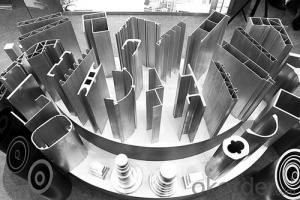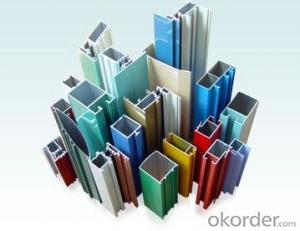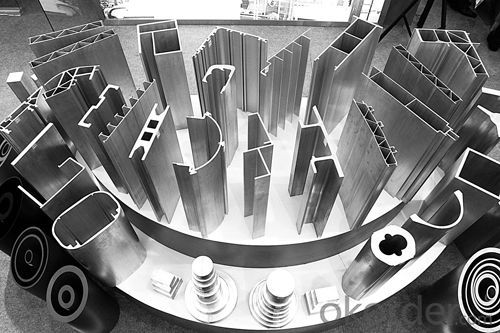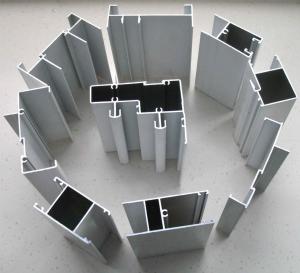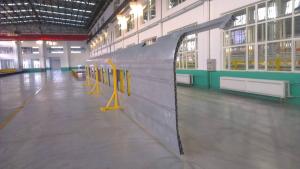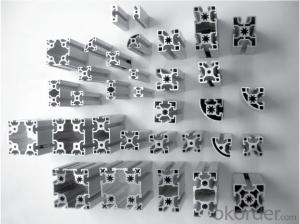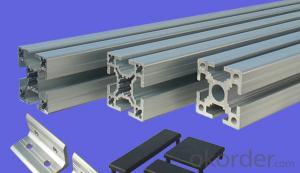Aluminum Extrusion Profiles California - Alu Perfil De Aluminio For Windows
- Loading Port:
- China Main Port
- Payment Terms:
- TT OR LC
- Min Order Qty:
- -
- Supply Capability:
- -
OKorder Service Pledge
OKorder Financial Service
You Might Also Like
Aluminium is a relatively soft,durable, lightweight, ductile and malleablemetal with appearance ranging from silvery to dull gray,depending on the surface roughness. It is nonmagnetic and does not easilyignite. A fresh film of aluminium serves as a good reflector (approximately92%) of visible light and an excellent reflector (as much as98%) of medium and far infrared radiation. The yield strength of pure aluminium is 7–11 MPa,while aluminium alloys have yield strengths ranging from200 MPa to 600 MPa. Aluminium has about one-third the density and stiffnessof steel. It iseasily machined,cast, drawn and extruded.
Alu Profile:
Material | Alloy 6063,6061,6005or according to customer’s choice |
Temper | T3, T4, T5, T6 |
Surface | Anodize, electrophoresis, powder coating, PVDF coating, wood grain painting, matted, etc. |
Length | Coating 6.5 meters, Anodizing 6.5 meters, Mill finish 5 meters |
Application | Industrial, electrical equipment(TV set, air conditioner, refrigerator, computer), decoration,construction, transportation |
Custom Made | We can package following with customer's request. |
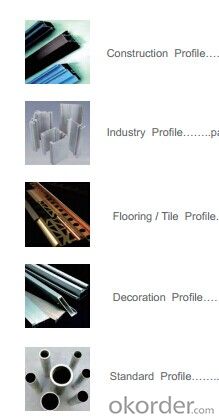
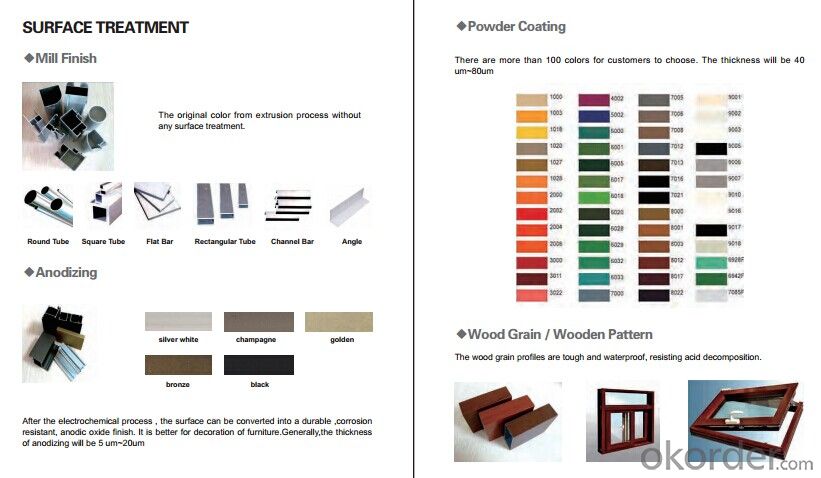
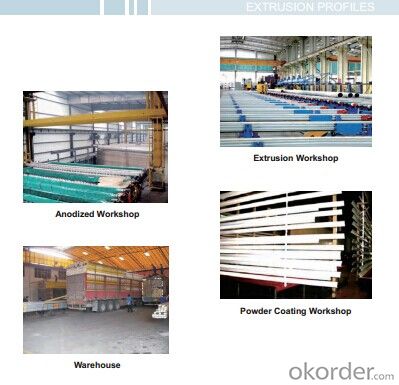
FAQ:
1. What is the form of payment?
Normally 30% TT, L/C at sight
2. Type of quotation?
FOB, CFR, CIF
3. Port of loading?
Guangzhou/Shenzhen port
4. Delivery time?
15-20 days after client’s deposit
- Q: This question asks about the variety of colors offered for aluminum profiles used in exterior siding and trim applications.
- <p>Aluminum profiles for siding and trimming are available in a wide range of colors to suit various architectural styles and design preferences. Common colors include white, black, brown, beige, and gray, which are popular for their neutrality and versatility. Additionally, there are bolder options such as red, blue, green, and yellow for more distinctive looks. Some manufacturers also offer custom color matching services for specific projects. The finishes can be powder-coated or anodized, providing durability and resistance to weathering. It's always best to check with specific manufacturers for the most up-to-date color offerings as they may introduce new colors or discontinue others based on market trends.</p>
- Q: What are the impact resistance properties of aluminum profiles?
- Aluminum profiles have excellent impact resistance properties due to their inherent strength and durability. They can withstand high impact forces without deforming or breaking, making them suitable for various applications where impact resistance is crucial, such as automotive, construction, and aerospace industries. Additionally, aluminum profiles can absorb and distribute impact energy effectively, minimizing the risk of damage or injury.
- Q: What are the aluminum profile markets in Cangzhou, Renqiu?
- Aluminum market, located in Renqiu city in Yi Zhen Zhang Liu Zhuang industrial area, if you find a direct about Liu Zhuang industrial zone can be. Known as the North's largest aluminum production base, I look not so good
- Q: Aluminum profile 606360056061, T5 and T6 hardness GB, how much?
- Generally divided into Vivtorinox hardness, Rockwell hardness and Vickers hardness and webster hardness. Our enterprises are generally in accordance with webster hardness test, GB 6063-T5 8HW 6063-T6 11.5HW6005-T5 15HW 6005-T6 15HW6061-T5 15HW 6061-T6 15HWIf you need other hardness units, you can refer to the conversion
- Q: Can aluminum profiles be used in interior design applications?
- Yes, aluminum profiles can definitely be used in interior design applications. Aluminum is a versatile and durable material that offers a wide range of design possibilities. It can be used to create various elements such as doors, windows, partitions, furniture frames, lighting fixtures, and decorative accents in interior spaces. Aluminum profiles are available in different shapes, sizes, and finishes, allowing for customization and flexibility in design. They can be anodized, powder-coated, or painted to match any desired color scheme. Additionally, aluminum profiles can be easily shaped and manipulated to create unique and intricate designs. One of the main advantages of using aluminum profiles in interior design is their lightweight nature, making them easy to install and handle. Moreover, aluminum is corrosion-resistant, meaning it can withstand moisture and humidity in areas like bathrooms and kitchens. Aluminum profiles also offer long-term durability, as they are resistant to warping, cracking, and fading. This makes them a suitable choice for high-traffic areas or commercial spaces that require frequent use. In terms of aesthetics, aluminum profiles can provide a modern and sleek appearance, enhancing the overall design of a space. They can be combined with other materials such as glass or wood to create a contemporary and sophisticated look. Furthermore, aluminum is a sustainable and eco-friendly material. It is fully recyclable, contributing to a reduced carbon footprint and a more sustainable design approach. In conclusion, aluminum profiles can be effectively used in various interior design applications. Their versatility, durability, lightweight nature, and aesthetic appeal make them a popular choice for designers seeking functional and visually appealing solutions for interior spaces.
- Q: What are the differences between horizontal and vertical aluminum profiles?
- Horizontal vertical hanger in the middle on the head,Therefore, the horizontal number will affect the surface a little, and when you have to find non decorative surface hangingThe vertical head is better, a hanging point, just cut off
- Q: Are aluminum profiles suitable for cleanroom partitions?
- Yes, aluminum profiles are often suitable for cleanroom partitions. Aluminum is a lightweight and durable material that is resistant to corrosion, making it a popular choice for cleanroom applications. It is easy to clean and maintain, which is crucial in maintaining the cleanliness and sterility of a cleanroom environment. Additionally, aluminum profiles can be easily customized and assembled, allowing for flexibility in designing cleanroom partitions to meet specific requirements. The versatility of aluminum profiles also enables the integration of various features such as doors, windows, and pass-through chambers, further enhancing the functionality of cleanroom partitions. Overall, with their excellent properties and adaptability, aluminum profiles are a reliable and suitable choice for cleanroom partitions.
- Q: How do you select the appropriate aluminum profile for a specific application?
- When choosing the right aluminum profile for a particular application, several important factors should be taken into account. To begin with, it is crucial to have a clear understanding of the application's requirements and specifications. This entails considering elements such as load-bearing capacity, structural integrity, and overall functionality needed for the application. Afterwards, it becomes essential to assess the attributes of the available aluminum profiles. This involves considering aspects such as alloy composition, strength, hardness, and corrosion resistance. Each application may have specific requirements in order to achieve optimal performance and durability. Moreover, it is important to evaluate the dimensions and shape of the aluminum profile. This includes considering factors like length, width, and thickness required for the application. Additionally, the shape of the profile, whether it is square, rectangular, or custom-designed, should also be taken into consideration. Another aspect to be taken into account is the surface finish of the aluminum profile. Depending on the specific application, the surface may need to be smooth, textured, or treated in order to enhance appearance or provide additional protection against wear, abrasion, or corrosion. Furthermore, it is essential to consider the availability and cost of the chosen aluminum profile. Evaluating the availability of the required profiles from different suppliers and assessing their cost-effectiveness is crucial to ensure that the chosen profile aligns with the budget and project timeline. Lastly, seeking expert advice and consulting with professionals who have experience in aluminum profiles for specific applications can be highly beneficial. They can offer valuable insights and recommendations based on their knowledge and expertise. In conclusion, selecting the appropriate aluminum profile for a specific application involves considering factors such as the application's requirements, the characteristics of the aluminum profile, dimensions and shape, surface finish, availability, cost, and seeking expert advice. By carefully considering these factors, one can choose the most suitable aluminum profile that will effectively meet the requirements of the application.
- Q: Are aluminum profiles suitable for exterior cladding systems that need to withstand fire?
- <p>Yes, aluminum profiles can be used for exterior cladding systems that require fire resistance. Aluminum is a non-combustible material, which means it does not support combustion. However, it's important to note that while aluminum itself doesn't burn, it can melt at high temperatures. To enhance fire resistance, aluminum profiles can be coated with intumescent paint or used with fire-resistant materials in the cladding system. These measures can help to slow the spread of fire and protect the structure. Always ensure compliance with local building codes and fire safety regulations when selecting materials for fire-resistant applications.</p>
- Q: Can aluminum profiles be used in sports equipment manufacturing?
- Yes, aluminum profiles can be used in sports equipment manufacturing. Aluminum is a popular choice in the manufacturing of sports equipment due to its lightweight yet durable properties. It allows for the creation of strong and sturdy equipment that is also easy to handle and maneuver. Aluminum profiles can be used in various sports equipment such as bicycles, tennis rackets, golf clubs, ski poles, and even lightweight frames for sports wheelchairs. The versatility and strength of aluminum make it an ideal material for sports equipment manufacturing, providing athletes with reliable and high-performance gear.
Send your message to us
Aluminum Extrusion Profiles California - Alu Perfil De Aluminio For Windows
- Loading Port:
- China Main Port
- Payment Terms:
- TT OR LC
- Min Order Qty:
- -
- Supply Capability:
- -
OKorder Service Pledge
OKorder Financial Service
Similar products
Hot products
Hot Searches
Related keywords
